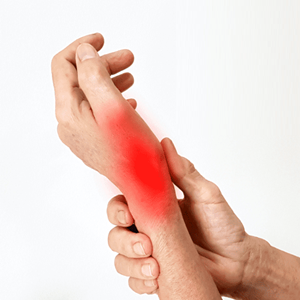


Pain in the hand or the wrist is a very common medical condition. This pain can be due to various reasons. So, it is vital to comprehend the cause behind the wrist pain. It can be due to some injury, fracture, repetitive stress, carpal tunnel syndrome or arthritis. Mentioned below are two main categories of wrist pain and their symptoms.
Carpal Tunnel Syndrome: Carpal Tunnel Syndrome is a common condition that occurs when one of the key nerves of hand such as the median nerve gets compressed or Squeezed. Because of this, the pain travels through the wrist.
Symptoms:
Numbness in hand.
Persistent aching in hand.
Weakness in muscles of the hand.
Wrist pain at night that interferes with sleep.
Tingling and pain in the thumb and first three fingers of the hand.
This is a kind of condition in which one of the fingers of your hand gets stuck in a bent position. The finger then straightens with a snap. The movement is akin to a trigger that is being pulled and then releases. This happens due to some kind of inflammation within the sheath that is present around the tendon in the affected finger.
Symptoms:
Stiffness in finger particularly in the morning.
Clicking sensation during movement of a finger.
Bump in the palm or a nodule at the base of the affected finger.
De Quervain tenosynovitis (dih-kwer-VAIN ten-oh-sine-oh-VIE-tis) is a painful condition affecting the tendons on the thumb side of the wrist. If you have de Quervain tenosynovitis, you will probably feel pain when you turn your wrist, grasp anything or make a fist. Repetitive hand or wrist movements can make the condition worse.
Symptoms:
The main symptoms are pain and tenderness in the wrist, often below the base of the thumb. Swelling can be present.
Treatment may include medication, physiotherapy or in rare cases, surgery. Treatment is generally successful when begun early.
Ganglion cysts are the most common mass or lump in the hand. They are not cancerous and, in most cases, are harmless. They occur in many locations, but most often develop on the back of the wrist.
These fluid-filled cysts can quickly appear, disappear, and change size. Many ganglion cysts do not require treatment. However, if the cyst hurts, if it affects function, or if you are unhappy with how it looks, there are several treatment options available.
Symptoms:
A ganglion cyst usually looks like a lump or bump on your wrist, finger or foot. This lump may look symmetrical (round) or misshapen (more like an oval).
A ganglion cyst sits just below your skin’s surface. It may look like a bubble blown from a joint. Ganglia sometimes have a translucent effect (you can see through the lump at certain angles).
Ganglion cyst treatments include:
Symptoms of a TFCC tear include pain on the outside of the wrist, reduced range of motion, swelling in the wrist, popping or clicking when moving the wrist, or limited ability to grasp objects.
The triangular fibrocartilage complex (TFCC) connects the bones in your forearm with bones in your wrist. The structure — made up of ligaments, tendons and cartilage — helps support and stabilize your wrist. You can tear your TFCC if you fall on, twist or fracture your wrist. TFCC tears can also result from tissue wearing down as you age.
Causes of TFCC tears:
Injury: The force of falling on your hand or wrist can tear your TFCC. A fall or other injury that fractures your radius can also tear your TFCC. A sudden twist of your arm that over-rotates your wrist can also cause a TFCC tear.
Degeneration: Like all tendons and ligaments in your body, your TFCC wears down and gets thinner with age. Thinner tissues are more likely to tear. These chronic TFCC tears often occur gradually over time. Repetitive motions (such as swinging a bat or racket) can also break down tissues that make up the TFCC, leading to tears.
In many cases, chronic or degenerative TFCC tears don’t cause pain or other symptoms. If you tear your TFCC as the result of an acute injury, you may have symptoms such as:
Recommended Treatments:
Medication: Anti-inflammatory medications (such as NSAIDs) can help reduce swelling and relieve pain.
Bracing: Keeping your forearm and wrist stable with a brace or splint can allow your TFCC to heal.
Injections: Cortisone shots help reduce the swelling of torn tissue.
Physical or occupational therapy: Exercises can strengthen the muscles in your wrist and forearm to prevent further injury.
Surgery: If more conservative treatments don’t provide relief, Doctor may recommend surgery. In most cases, minimally invasive arthroscopic surgery can repair TFCC tears.